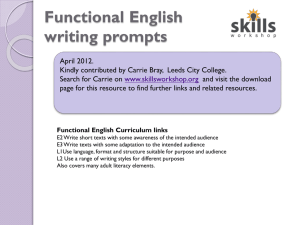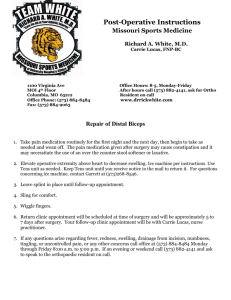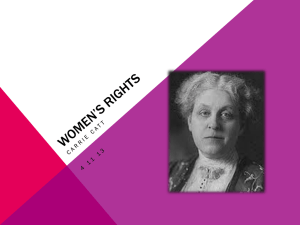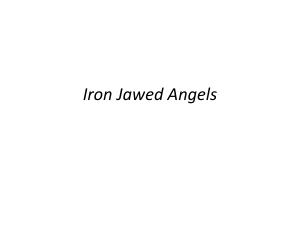Micro-Ethnography - Natalie Lanham: First Year Writing
advertisement
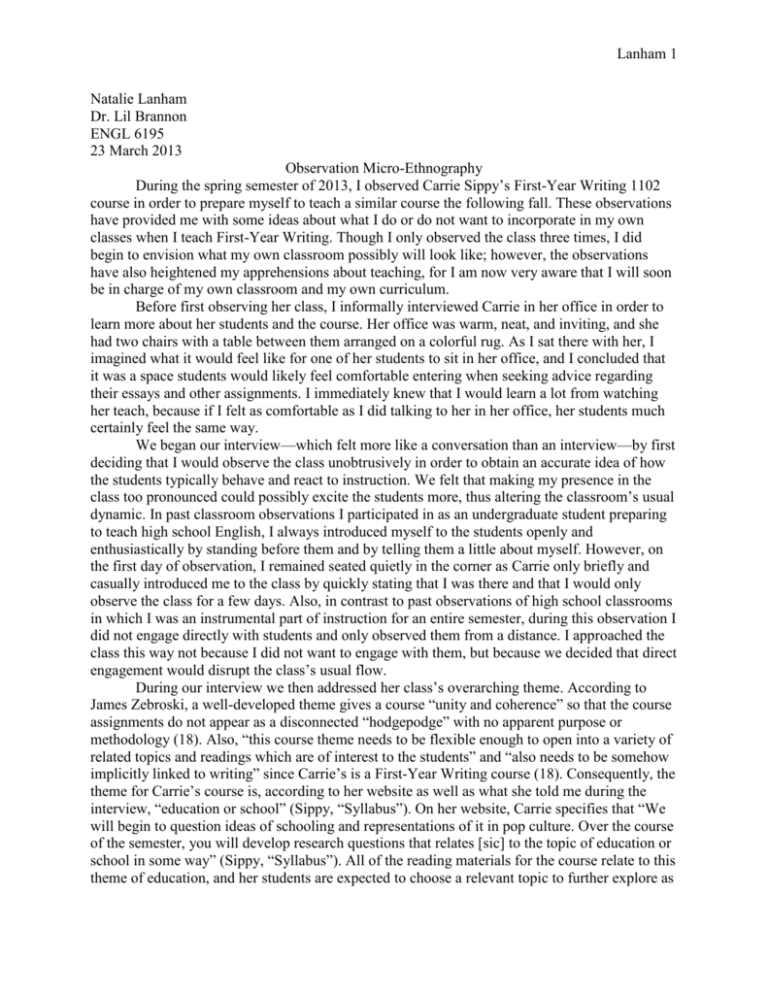
Lanham 1 Natalie Lanham Dr. Lil Brannon ENGL 6195 23 March 2013 Observation Micro-Ethnography During the spring semester of 2013, I observed Carrie Sippy’s First-Year Writing 1102 course in order to prepare myself to teach a similar course the following fall. These observations have provided me with some ideas about what I do or do not want to incorporate in my own classes when I teach First-Year Writing. Though I only observed the class three times, I did begin to envision what my own classroom possibly will look like; however, the observations have also heightened my apprehensions about teaching, for I am now very aware that I will soon be in charge of my own classroom and my own curriculum. Before first observing her class, I informally interviewed Carrie in her office in order to learn more about her students and the course. Her office was warm, neat, and inviting, and she had two chairs with a table between them arranged on a colorful rug. As I sat there with her, I imagined what it would feel like for one of her students to sit in her office, and I concluded that it was a space students would likely feel comfortable entering when seeking advice regarding their essays and other assignments. I immediately knew that I would learn a lot from watching her teach, because if I felt as comfortable as I did talking to her in her office, her students much certainly feel the same way. We began our interview—which felt more like a conversation than an interview—by first deciding that I would observe the class unobtrusively in order to obtain an accurate idea of how the students typically behave and react to instruction. We felt that making my presence in the class too pronounced could possibly excite the students more, thus altering the classroom’s usual dynamic. In past classroom observations I participated in as an undergraduate student preparing to teach high school English, I always introduced myself to the students openly and enthusiastically by standing before them and by telling them a little about myself. However, on the first day of observation, I remained seated quietly in the corner as Carrie only briefly and casually introduced me to the class by quickly stating that I was there and that I would only observe the class for a few days. Also, in contrast to past observations of high school classrooms in which I was an instrumental part of instruction for an entire semester, during this observation I did not engage directly with students and only observed them from a distance. I approached the class this way not because I did not want to engage with them, but because we decided that direct engagement would disrupt the class’s usual flow. During our interview we then addressed her class’s overarching theme. According to James Zebroski, a well-developed theme gives a course “unity and coherence” so that the course assignments do not appear as a disconnected “hodgepodge” with no apparent purpose or methodology (18). Also, “this course theme needs to be flexible enough to open into a variety of related topics and readings which are of interest to the students” and “also needs to be somehow implicitly linked to writing” since Carrie’s is a First-Year Writing course (18). Consequently, the theme for Carrie’s course is, according to her website as well as what she told me during the interview, “education or school” (Sippy, “Syllabus”). On her website, Carrie specifies that “We will begin to question ideas of schooling and representations of it in pop culture. Over the course of the semester, you will develop research questions that relates [sic] to the topic of education or school in some way” (Sippy, “Syllabus”). All of the reading materials for the course relate to this theme of education, and her students are expected to choose a relevant topic to further explore as Lanham 2 part of their semester-long research project and to which they will return “through a progression of assignments” (Sippy, “Syllabus”). During our interview, she indicated that some of her students’ topics address standardized testing in education, student athletics, teaching styles, as well as the question of whether or not college is actually necessary for success. According to Zebroski, the ideal theme for a writing course is “open-ended” and includes “a question to be investigated, without any preformed correct answers decided upon in advance” (18); thus, the theme for Carrie’s class fits Zebroski’s criteria well because it is broad in scope and allows for many different possible directions the students can take their research. It is certainly important to choose a theme to which students can easily relate, and Carrie’s theme achieves this for education is an inextricable part of students’ daily lives. Carrie also indicated during the interview that she uses a blog through Yolasite.com to communicate with her students and to post assignments, readings, and other documents, such as her syllabus. In her syllabus, Carrie describes the “sequence of assignments” that builds on an essential inquiry idea related to the theme of education (Sippy, “Syllabus”). According to her syllabus, before beginning this semester-long inquiry project, the students create a blog, on which they post a list of potential inquiry questions they will explore for their research projects. According to the students’ blogs, one student has chosen to research the benefits of requiring students to take a personal finance course in order to learn how to manage their money. Other students chose to research the negative effects of standardized testing on students’ learning, as well as how participating in student athletics may positively or negatively affect academic achievement. After choosing their essential inquiry topics, the students then research sources to use for their projects. Thereafter, the students create an annotated bibliography and a unique academic conversation assignment before writing their final research paper. The students will finally include all this work from each phase of the semester-long inquiry project into their final portfolios, which will ultimately reflect the idea that writing is a process containing many stages. During the three days I observed the class, the class was working on the academic conversation assignment phase of their overall inquiry projects. This assignment requires the students to compile all their secondary sources and create a conversation between the authors of those sources in the format of a dialogue or play. According to the guidelines for this assignment, Carrie desires her students think about how the sources “work with or against each other” to create a cohesive conversation and about how the students can themselves then enter into that conversation (Sippy, “Academic Conversation”). On this assignment sheet, Carrie states to her students, “Imagine that you enter a parlor. You come in late. When you arrive, others have long preceded you, and they are engaged in a heated discussion . . . You listen for a while . . . then you put in your oar . . .” (Sippy, “Academic Conversation”).This assignment functions to make students aware that the purpose of conducting research is to explore what scholars are already saying about a topic and to then determine how to enter into that extant conversation. By constructing a conversation among scholars, the students learn that existing academic conversations do exist among scholars and among texts, and that researching sources serves to help discover what this existing conversation already addresses and then to determine how to fit oneself into such a conversation. On the first day of my observations, the students worked on their academic conversation assignments by workshopping in small groups of three to four students. In these groups the students spent approximately12-15 minutes reflecting on each other’s academic conversation pieces and discussing what each group member accomplished successfully, what s/he could improve, and the questions they still had about their group members’ texts. They were then Lanham 3 expected to share their notes about each other’s papers in a Googledoc. As the students workshopped in their inquiry groups, Carrie walked around the room and asked each group if they had any questions. As she moved around the room, I wanted to hear more closely the students’ discussions, so I seated myself close to a few groups while still maintaining an unobtrusive presence. As I listened to the students discussing their academic conversation assignment, I noticed quickly that when their teacher was out of earshot, they turned their attention away from workshopping and, instead, engaged in unrelated conversation. If I had not assumed this unobtrusive role, and if I, instead, performed more as a co-instructor or authority figure, the students would have perhaps resumed discussing their assignments when I was nearby; however, given the circumstances, I had the opportunity to obtain an accurate understanding of how the students really engage with each other when the teacher is not within their immediate space. During workshopping, one student brazenly texted almost the entire hour with seemingly no concern for Carrie’s presence. Carrie, though, informed me later that this particular student rarely turns in assignments, and that she does not attempt to intervene or to motivate that student. She explained to me that on the first day of classes she directly informed the students that they are adults, and that in college it is not her job to babysit them. She emphasized to them that they are responsible for keeping up with their assignments, but if they should come to her in advance to express genuine concern over classwork, she will do everything she can to help them. So, in the case of the student texting the entire workshop period, Carrie does not spend time monitoring that student because that person is an adult who can autonomously choose whether or not to participate. At the beginning of this and every class day, Carrie asks her students to write in their daybooks, and she displays their writing prompt on the overhead. The first day I observed the class their “writing into the day” prompt was “What do you still need to know about your academic conversation project? What will make the project clearer for you? If you are planning on interviewing individuals, how many people do you need to talk to?” This prompt in part functions to help students to think about the directions of their academic conversation projects; additionally, the prompt gives students a space to articulate their confusions regarding the assignment, and because Carrie will not necessarily read these daybook entries her students’ confusions may go unnoticed. Therefore, Carrie often has her students express their confusions in a “ticket-out-the-door” [my terminology], which are slips of paper the students hand Carrie as they leave class. At the end of the first day I observed, Carrie asked her students to answer the questions “What helped you understand (the assignment, reading, etc.)?” “What was made clearer?” “What confused you?” “What questions do you still have?” in order for her to become better aware of her students concerns and, thus, perhaps modify her instruction accordingly. The students spent the rest of this class day in their workshopping groups, and Carrie gave them the entire class session (from 9:30 am to 10:45 am, or one hour and fifteen minutes) to discuss each other’s academic conversation essays. However, I noticed very quickly that the students only had a few comments to make for each and that they ended up spending nearly forty-five minutes chatting quietly with each other and trying to maintain the appearance of actually working on the assigned task. Carrie appeared to assume that they were diligently working, but I noticed the opposite: many of the students spent the last fifteen minutes of class on their cellphones, on Facebook, or simply staring off into space. During the last few minutes of class they no longer even attempted to appear on task, and they almost blatantly tapped away on their cellphones while they were supposed to be workshopping. Thus, I believe Carrie allowed Lanham 4 too much time for workshopping, and the second half of class time could have been used much more constructively. The students seemed to spend little time on the assigned task and the majority of class mostly sitting or feigning participation. Prior to workshopping, Carrie did not given her students any instructions for how to peer review each other’s work, nor did she discuss some of the goals of peer reviewing. (Though, this is not to say that she had not done this on some prior occasion during the semester.) It seemed that Carrie did not want to give them too many instructions about how to review each other’s work because she wanted them to freely and authentically engage in group discussion. Perhaps she was taking advice from Mark Hall who, in his article “The Politics of Peer Response,” emphasizes how the teacher should “step back” from the peer review process in order for students to truly learn to think critically about writing and responding (4). According to Hall, when students receive a peer response worksheet to use while workshopping, students then “spend most of the time dutifully—and silently—filling out [the] worksheet” (4). Therefore, instead of constraining students with worksheets and limiting questions for response, peer workshops should allow students an opportunity to personally engage with each other’s writing the way they see fit. Thus, perhaps Carrie did not give her students more guidelines for how to go about peer workshopping in order to not limit their personal engagement with each other’s texts. However, her desire not to constrain her students may have backfired because without any guidelines at all for effective workshopping, her students’ conversations about each other’s papers greatly consisted of discussing “lower order” concerns, such as citations, formatting, spelling, etc. I overheard one group of students debating whether “affect” or “effect” is the correct verb form, and I heard another discussing how to cite an internet source. A few students also addressed whether to use brackets or parentheses to enclose “stage directions” (they had written their academic conversations as a play of some sort). I did not hear many students really discussing their reasons for choosing to write their academic conversations as they did (either as a play, screenplay, radio broadcast, television interview, informal exchange at a coffee shop, etc.). It would have been interesting to hear more about their reasons for choosing their modes for presenting their academic conversations and how those modes did or did not work well for their purposes. Also, there was no discussion regarding their reasons for having chosen particular quotes from their scholars. How did those quotes help drive their scholars’ conversations with each other forward? What may the students have overlooked when drafting their academic conversations? How could they improve their work on a more contextual level? Not providing the students with any guidelines for effective peer reviewing also resulted in the students not taking full advantage of their workshopping groups. Most of the students did not spend much time working with their groups, and many students did not participate at all. At one point, and for several minutes, two of the five groups were completely silent. For the most part, the students essentially spent a few minutes telling each other what they liked or didn’t like about each other’s papers, and then spent the rest of the class time (at least thirty to forty minutes) chitchatting with one-another, texting, or sitting idle. Thus, they truly needed some guidelines for how to go about reviewing each other’s writing because without this they floundered completely. Even Hall does not advocate having students blindly respond to each other’s writing. According to Carrie, workshopping day is not an opportunity for the teacher to demonstrate his or her “hovering presence” (Sippy, “Personal interview”). She prefers to avoid micromanaging students’ workshop groups at all costs in order for the students to construct their own learning. Yet, perhaps in this case some guidance would have helped the students because Lanham 5 without any recommendations at all they didn’t seem to know how to truly engage with each other’s work. Another reason the students did not seem to participate fully in their peer workshops was perhaps that they did not feel they benefited much from the academic conversation assignment in general. On workshopping day, I heard several students say to each other under their breath that they thought the academic conversation assignment was “stupid” and “super easy”; therefore, they perhaps didn’t engage very much in critical dialogue with one-another because they did not take the assignment seriously and were not challenged by it. A more challenging assignment may have inspired more thoughtful conversation and interaction amongst the students. However, the assignment designer (essentially, their teacher) may not have been completely to blame for the students’ lack of engagement with the task; the academic conversation assignment required the students to create a dialogue between scholars, and I overheard a few students talking about how they used profanity in their scripts. Several students did not seem to approach the assignment very maturely, and they may have gleaned more from it if they had written their scholars as having intelligent conversations with each other, as well as with more focus on the academic topic and less on their scholars using profanity and talking about unrelated, senseless ideas. One student asked Carrie if he could have one of his scholars use profanity, and Carrie kindly replied by telling him, “The goal is not to scare off your readers,” and “Don’t just do it for the shock factor.” It seems the students were more focused on the task of improvisation in their academic conversation pieces, and less so on the academic aspects of their scholars’ conversations. They had fun creating the imaginary conversations (or interviews, or scripts), but they seemed to miss the main goal of focusing on how their scholars co-construct an academic conversation. During the next class session, Carrie did not seem to notice how little time the students spent workshopping and how much class time was wasted because she asked the students if they still needed more time to work in their workshop groups. Not surprisingly, the students declined the offer for more time, though Carrie thought her class actually needed more time for this task. However, Carrie was possibly aware all along that the students did not make the most of their workshopping time, and she, therefore, wanted to give them a second chance to make up for the time they wasted. Yet, regardless, the students during the next class session instead began thinking about the second draft of their academic conversation pieces, which they would alter based on the suggestions they received from their peers during workshopping. These second drafts function as a bridge to prepare the students for writing their final research papers. While draft one of the academic conversation piece is much more conversational and informal, for the students were to construct a conversation between scholars modeling a script or screenplay, draft two is more reminiscent of an academic essay, though one that is still not quite as polished and cohesive as their final research papers will be. For draft two, which is essentially a stepping stone to composing their final formal essays, the students must make the very informal conversations between scholars in draft one sound a bit more academic, while still retaining elements of their personal writing voices and styles. In order to prepare her students for writing draft two, Carrie planned to spend class time discussing with them the conventions of formal essays and how they can perhaps negotiate some of those conventions. She first asked her students (as usual) to “write into the day” in their academic journals by reflecting on what they like or hate about writing academic essays. As they wrote in their daybooks, she asked them to consider and list some of the conventions for formalist research papers. However, after they started writing, one student asked Carrie for clarification about the meaning of “writing conventions.” Carrie and I are likely so familiar with Lanham 6 the idea of writing conventions that we perhaps neglect recognizing that for most students, especially those just beginning college, this may be a new concept. Carrie explained to the student that she means the “rules” for writing academic essays, and she seemed to dispel the students’ confusion. After the students wrote for approximately five minutes, Carrie then asked the class to combine into groups of three or four to discuss their ideas regarding writing conventions with their groupmates for approximately ten minutes. Then, they talked about writing conventions openly as a class, and the students began to call out what they believed were some examples of writing rules. Some of their examples included “no first person,” “papers must have structure,” and “formal tone.” Though a few students seemed confused by the definition of “writing conventions,” others seemed to have a solid understanding of the topic for a few provided some great examples of writing rules, including no contractions, a clear thesis statement, and use of active voice. It was exciting to hear the great ideas these students had about writing conventions, and it was reassuring to know many students already have some knowledge about this subject. Having her students think about writing conventions functioned to teach them that many of these conventions are negotiable, and that the second draft of their academic conversation assignment is a space where they can negotiate these conventions. She also showed them a copy of her own graduate thesis (which she had written using a more informal tone) to demonstrate to the students that a strictly academic, formal tone is not always necessary and appropriate for every genre of writing. They seemed surprised that the sample was Carrie’s own writing because it was more conversational (though not extremely so) than they perhaps expected it should be. Carrie’s method of showing students her own writing and how her writing styles vary based upon audience and genre is a great way to demonstrate to students that conventions can be negotiated and that rules are genre-specific. Interestingly, though, Carrie had to almost coax many of her students to provide examples of writing conventions without waiting to be called upon. A few students seemed completely comfortable speaking out in class without Carrie soliciting their input. However, several others appeared hesitant to call out answers freely. A few sat with their hands in the air, waiting for Carrie to acknowledge them individually, but she told the class to “just call out answer” when she recognized this. Carrie makes every effort to create a more collaborative classroom, and her entreaty for her students to participate without solicitation from her reflects this desire. Perhaps some students felt hesitant to freely speak out because students for so long have been socialized to think of classrooms as spaces controlled by hierarchies, and where the teacher moderates the flow and exchange of ideas. Therefore, this traditional perspective of classrooms as places where students must “wait their turn” and “stay silent until called upon” has perhaps hampered many students from participating openly and excitedly in class discussion. While Carrie’s students called out their ideas, Carrie wrote those ideas on the board, and she did not respond after each student offered an example. In fact, she allowed the students the freedom to voice their ideas without immediate responses from her, and she did not interrupt if one student happened to respond to another without her input. Carrie seeks to move away from what Glynda Hull et al. call “the IRE sequence,” which refers to when “a teacher initiates, a student replies, and the teacher evaluates” (301). In a traditional, formalist classroom, “the student’s reply to this initiation can be non-verbal, such as raising a hand or carrying out an action . . . and the teacher comments on the student’s reply” (Hull et al. 302). However, in Carrie’s classroom, she does not always insist on evaluating every student’s response, and she often allows room for students to reply to each other. In a typical, formalist classroom, “It’s not Lanham 7 appropriate . . . for students to speak after any speaker’s turn except the teacher’s initiation” (Hull et al. 305); yet, in Carrie’s class, students experience more freedom to engage with each other authentically, and conversation can thus evolve organically. She embraces the sort of classroom environment that allows for respectful debate and discussion, because without such an environment critical thinking skills cannot begin to flourish. Also, if Carrie is to treat her students as adults, she must also acknowledge their maturity to engage in lively discussion without hurting others and without descending into absolute chaos and disruption. After having observed Carrie and her students work on and discuss the academic conversation assignment, I asked Carrie during our final interview some of her thoughts regarding the assignment and if she would do anything differently the next time she teaches it. She indicated that in the future she needs to focus more on helping her students more clearly understand the goals of the second draft of the academic conversation piece. Her students this semester lacked a clear vision of what the second draft should look like—that it is a bridge between the much more informal academic conversation draft one with the more formal final research paper. She expressed to me that in order to help future students better understand draft two, she plans to spend more time after draft one helping her class think critically about the conventions of formalist academic writing. She seeks to engage her future students more in thinking about the arbitrariness of most writing conventions and how they may negotiate some of those rules for writing. She believes that by discussing these ideas more before starting draft two, her students will develop a clearer sense of how they can move into writing a more formal research paper while still retaining some of their writing voice that appeared strongly in the first draft of their academic conversation pieces. Also, Carrie expressed that the next time she teaches this assignment she will fortunately have acquired a set of writing samples for draft two (as well as for draft one and the final research papers) from students in her current class. She will be able to provide future students with writing samples furnished by previous students that will help future students see and conceptualize draft two more clearly. However, Carrie noted that she often avoids this teaching method of providing samples to students because she believes doing so tempts students to “extrapolate some formula” from the samples to follow for their own papers (***). According to Carrie, students very often believe they will make a good grade if they emulate the previous student’s organization, tone, and other writing strategies. She believes providing writing samples can sometimes hinder students from exploring their own ideas and writing voices. Therefore, she approaches providing writing samples carefully and alert to the possibility that doing so may inadvertently impose conventions when she really desires to deviate completely from imposing such conventions. In fact, while writing this micro-ethnography, I have considered how writing samples may constrain my own writing. In preparation for this assignment, my class received samples of former graduate students’ micro-ethnographies as a guide for how to possibly conceptualize our own essays. Though I did glance at these samples, I intentionally did not spend too much time studying them. I did not want to familiarize myself too much with what previous graduate students wrote for this assignment because I did not want that knowledge to constrain my own writing. I only quickly glanced at the sample micro-ethnographies to get a general sense of the level of formality expected of this assignment, but I did not completely read through the samples. As a result of my own experiences with writing samples, as well as with listening to Carrie’s ideas about the negative impact of samples on students’ writing, I believe perhaps the best approach in the classroom is to provide the samples in class, and to witness them and talk about Lanham 8 them during class time, rather than providing students with a sample they can repeatedly refer to at home, which may tempt them to focus too much on the sample and less on composing their own drafts. Rather, discussing the sample in class only can introduce students briefly to previous students’ work, but will help prevent current students from “extrapolating a formula.” They can leave the class with a general sense of what is expected of their essays rather than with a rigid formula they can imitate. Carrie has created a classroom that embraces a constructivist model for teaching, which emphasizes collaboration and questions power structures and behavioral norms. It is a classroom that understands “perception, behavior, and knowing as emergent from the processes of living in the world,” or, in other words, one that recognizes learning as socially-constructed (Cooper 421). It is a space that does not believe in absolute Truths and does not believe teachers are the single, absolute holders of Truth; rather, the constructivist classroom perceives students and teachers as equal holders of multiple, often divergent Truths. Carrie’s space invites the egalitarian sharing of and responding to ideas. To construct a classroom that deviates from traditional power structures, Carrie prefers her students call her by her first name, and she does not at all expect her students to defer to her as “Ms. Sippy,” because she wants to foment a classroom environment where students and teachers are all equal participants in learning. Nor does she position herself as the purveyor of all great knowledge, and she recognizes that her students enter the space with their own unique perspectives and understandings of the world. They may know many things she does not, and she strives to build a space where they are at liberty to share that knowledge. During our interview, she expressed that she is not a “depositor of info” that her students must accept unquestioningly. She bases her teaching ideology on Paulo Freire’s Pedagogy of the Oppressed, and this is one of the first readings she assigns her students in order to introduce them to the culture of her classroom. Observing Carrie and her class greatly helped me construct my own conceptions for my own future classroom, and I have received many concrete ideas for assignments I do or do not intend to incorporate. I also do agree with Carrie’s constructivist approach, though I also believe that students need some guidelines, particularly with peer reviewing workshop exercises. Yet, overall, the experience was extremely enriching and rewarding and will benefit me immensely as I embark on my own teaching experience. Lanham 9 Works Cited Cooper, Marilyn M. “Rhetorical Agency as Emergent and Enacted.” CCC 62.3 (2011): 420-43. Print. Hall, Mark. “The Politics of Peer Response.” thewritinginstructor.com/hall. Jul. 2009. Web. 23 Jul. 2009. Hull, Glynda, et al. “Remediation as Social Construct: Perspectives from an Analysis of Classroom Discourse.” College Composition and Communication 42.3 (1991): 299-326. Print. Sippy, Carrie. Personal interview. 18 Mar. 2013. ---. “Academic Conversation Assignment Sheet.” ENGL 1102-006: Writing and Inquiry in Academic Contexts 2. University of North Carolina Charlotte, n.d. Web 6 Apr, 2013. ---. “Syllabus.” ENGL 1102-006: Writing and Inquiry in Academic Contexts 2. University of North Carolina Charlotte, n.d. Web 6 Apr, 2013. Zebroski, James T. Thinking through theory: Vygotskian Perspectives on the Teaching of Writing. Portsmouth, NH; Boynton/Cook Publishers, 1994. Print.


